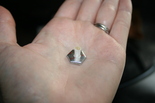 I recently had to have blood drawn, and as per usual with me, the area quickly turned a beautiful shade of black-and-blue. Just in time for summer!
I recently had to have blood drawn, and as per usual with me, the area quickly turned a beautiful shade of black-and-blue. Just in time for summer!
When I went to my acupuncturist a few days later, she gave me a treatment using moxa–a traditional Chinese herb also known by its Harry Potter-esque name mugwort.
There are two layers to moxa treatment. The first has to do with the herb itself, which is mildly toxic if eaten. In some cultures, mugwort is used for divination, or placed under pillows to induce vivid dreams. Mugwort becomes moxa when it is aged and ground up. Also, it smells just like pot.
The second layer of moxa treatment is the manner in which it’s administered. My acupuncturist uses these sticks that are packed full of moxa “fluff” and stuck onto metallic discs that are sticky on one side. The moxa is lit like incense, and placed, smoking, on the area to be treated. Once I report feeling “warm,” she removes the moxa and extinguishes whatever is still smoking.
Here’s the thing–within hours, the big ugly bruise on my arm had visibly faded, and the next morning the skin where the moxa had sat was perfectly clear and bruise-free. So the stuff works. How? I’m not entirely sure–and sometimes with acupuncture treatments, I just relax into trusting thousands of years of tradition without worrying too much about how that tradition translates into modern science.
But what I do know is that the purpose of moxa is to stimulate blood flow, energy flow, and general circulation. Bringing blood into a bruise site–and thereby moving “old” blood out–is what makes moxa helpful in treating bruises, among other things.
Have you ever tried moxa? Amazing stuff, no?

